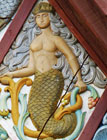[nggallery id=11]
The Mandrogy Collective is complex of farmstead-type ornate houses, craft workshops, a school, a mill, horse stables, and a rabbit farm. Even though there is an extensive Vodka Museum, there are two inviolable rules: “Nobody drinks [alcohol] and nobody steals in the village.”
More than 150 people live in Mandrogy full time, and another 200 come here to work such as instructing visitors as they learn to weave, embroider, paint matroyshkas, make pottery and carve wood. Earned resources are distributed among members of the collective, and children study free of charge.
Vodka, the national drink of Russia, is a beverage “suited to all occasions.” The word is a derivative of vodka (water), and means “little water.” Made from potatoes, corn, or wheat, license-produced vodka is 80 proof (40% alcohol). Some experts believe that vodka, as we know it, dates from the 14th century. Others credit Peter the Great with bringing potatoes—and strong drink—to Russia around the turn of the 17th century.
Approximately four billion liters of vodka are consumed in Russia per year, amounting to up to 38 bottles of vodka per adult. Perhaps contributing to the high consumption rate, drinking vodka is the traditional means to seal business contracts, and the ritual is central to any celebration.
In 1985, Gorbachev made a valiant attempt to restrict the population’s consumption of vodka. His campaign was hugely successful in the short term, with smaller, state-controlled quantities of alcohol produced and a decrease in alcohol-related deaths. But demand exceeded supply, and bootleg vodka was soon produced. Under Yeltsin, the state monopoly was lifted, but some 60% of Russian vodka is still produced illegally.









